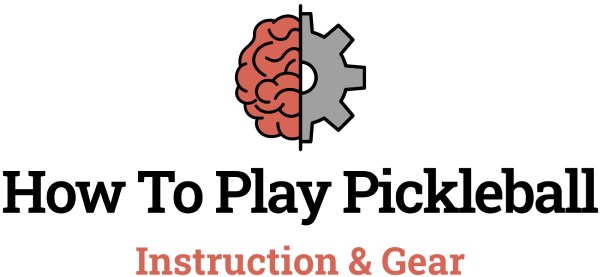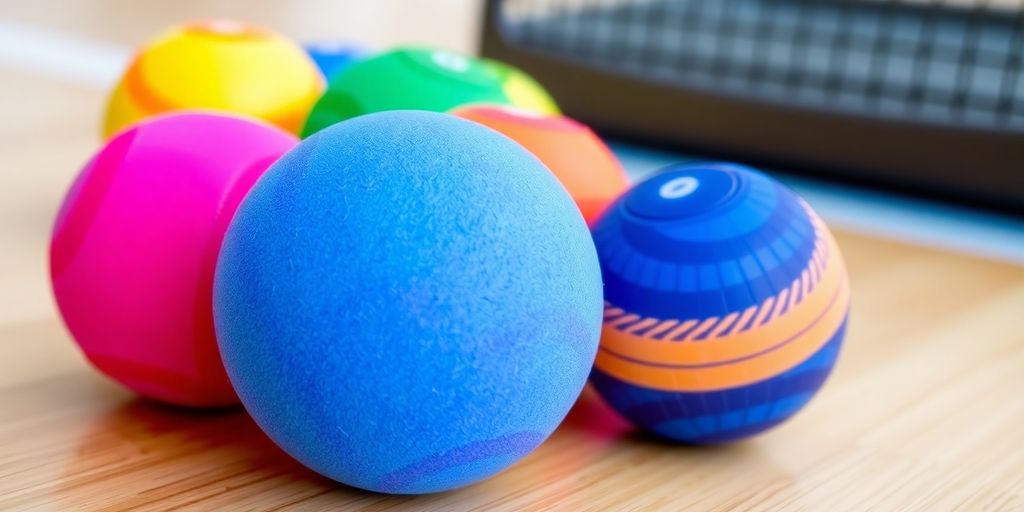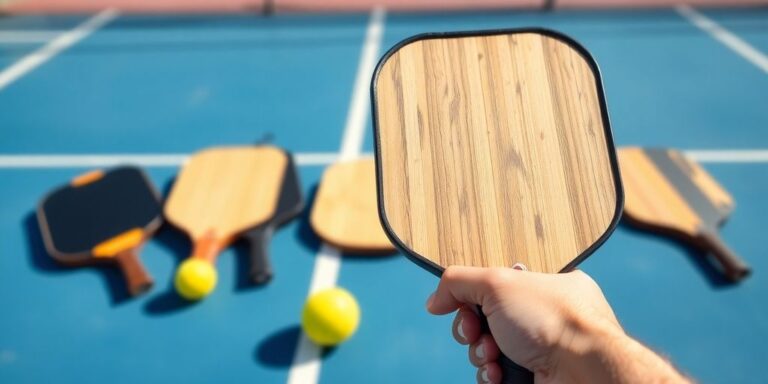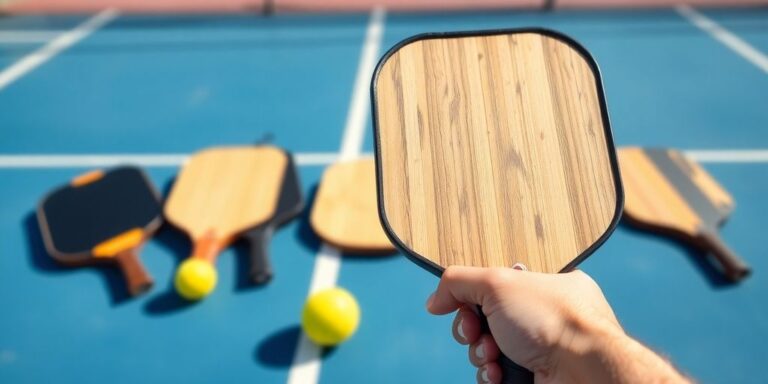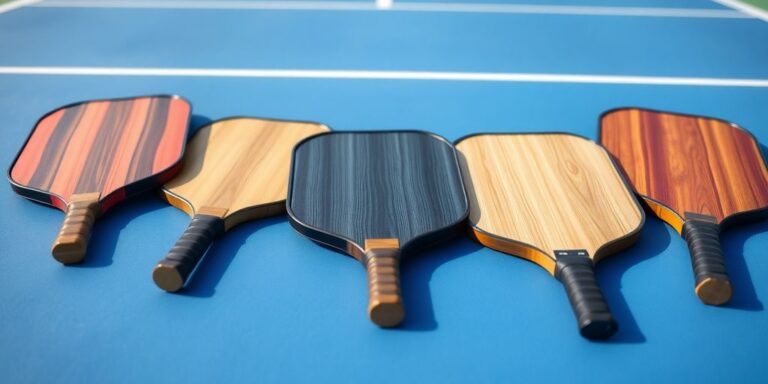If you’re looking to up your pickleball game, choosing the right indoor pickleball balls is key. These balls are specially made for indoor courts, and using the right kind can really impact your performance. In this guide, we’ll explore what makes indoor pickleball balls unique, how to pick the best one for your needs, and some essential tips to keep in mind while playing indoors.
Key Takeaways
- Indoor pickleball balls are designed specifically for indoor surfaces, offering better control and bounce.
- Choosing the right material, like plastic or composite, affects durability and performance.
- Size and weight variations can influence gameplay, so it’s important to find what feels right for you.
- Color matters! Picking a ball that contrasts with the court helps with visibility during play.
- Regular maintenance and knowing when to replace your balls can enhance your overall game experience.
Understanding Indoor Pickleball Balls
Key Features of Indoor Balls
Indoor pickleball balls are designed with specific features to optimize play on indoor courts. These balls are typically made of a softer plastic material compared to outdoor balls. This softer construction allows for better control and a more consistent bounce on the smoother, often less forgiving, indoor surfaces.
Here’s a quick rundown of key features:
- Softer plastic material
- Larger holes (usually around 26)
- Lighter weight compared to outdoor balls
- Designed for controlled bounce and play
Benefits of Using Indoor Balls
Using the correct type of ball can really change your game. Indoor pickleball balls offer several advantages when used on indoor courts. The softer material reduces the speed of the game, allowing for more strategic play and better control. The larger holes also contribute to a more predictable flight path, which is super helpful when you’re trying to place your shots accurately. Plus, indoor balls tend to be quieter than their outdoor counterparts, which is a nice bonus if you’re playing in a shared space or a facility with noise restrictions. Using indoor pickleballs can really improve your game.
Common Misconceptions About Indoor Balls
There are a few things people often get wrong about indoor pickleball balls. One common misconception is that they’re all the same. In reality, there can be variations in material, weight, and hole size, all of which affect performance. Another misconception is that you can use indoor balls outdoors without any issues. While you can technically do this, indoor balls aren’t built to withstand the wear and tear of rough outdoor surfaces, and they’ll likely wear out much faster. Also, don’t assume that a ball is an indoor ball just because it’s a certain color. Always check the specifications to be sure. It’s important to choose the right pickleball balls for the right environment.
It’s a mistake to think you can just grab any pickleball and expect it to perform well indoors. Indoor balls are engineered for a specific type of play, and using the wrong ball can negatively impact your game and even lead to frustration. Take the time to understand the differences and choose wisely.
Material Considerations for Indoor Pickleball Balls
Plastic vs. Composite Materials
When you’re picking out indoor pickleball balls, the material is a big deal. You’ll usually find two main types: plastic and composite. Plastic balls are often more budget-friendly and can take a beating, which is great if you’re just starting out or playing casually. Composite balls, on the other hand, tend to offer better performance, giving you more control and a different feel when you hit the ball. It really comes down to what you value more – cost-effectiveness or enhanced play. For example, if you are looking for the best pickleball paddles, you should consider the material as well.
Impact of Material on Performance
The material of the ball has a direct impact on how it performs. Plastic balls generally have a livelier bounce and can be a bit harder to control, especially if you’re used to outdoor balls. Composite balls often provide a more consistent and predictable bounce, which can help with your accuracy and shot placement. The softer feel of composite balls can also reduce the impact on your arm, which is something to think about if you play frequently. The best pickleball balls are made of hard plastics like polypropylene and polyethylene.
Durability and Longevity of Indoor Balls
Indoor pickleball balls, because they’re used on smoother surfaces, tend to last longer than outdoor balls. However, the material still plays a role in their durability. Plastic balls are generally very durable and can withstand a lot of use before showing signs of wear. Composite balls might not be as tough, but they often maintain their performance characteristics for a longer period.
It’s a good idea to inspect your balls regularly for cracks or dents. Even if they look okay, a change in bounce or feel can indicate that it’s time for a replacement. Keeping your balls clean and storing them properly can also extend their lifespan.
Here’s a quick comparison:
| Feature | Plastic Balls | Composite Balls |
|---|---|---|
| Cost | Lower | Higher |
| Durability | High | Medium |
| Bounce | Lively | Consistent |
| Control | Less | More |
| Court Surface | Indoor | Indoor |
| Longevity | Medium | High |
Choosing the Right Size and Weight
It’s easy to overlook the size and weight of a pickleball, but trust me, it matters! Getting this right can seriously improve your game, especially indoors. Let’s break down what you need to know.
Standard Sizes for Indoor Pickleball Balls
Okay, so the official size for a pickleball, whether you’re indoors or out, is pretty consistent. We’re talking about a diameter of 2.87 to 2.97 inches. That’s what the USAP standards say, and it’s what you’ll find most balls adhere to. You might see slight variations, but generally, they stick to this range. Why? Because it affects how the ball interacts with your paddle and the court surface. Too big or too small, and things just won’t feel right.
Weight Variations and Their Effects
Now, let’s talk weight. The official weight range is 0.78 to 0.935 ounces. While that might not sound like a lot, those tiny fractions of an ounce can make a difference. Lighter balls tend to be favored indoors because they offer more control and are easier on the arm during those long rallies. Heavier balls, on the other hand, can give you more power, but they might also lead to fatigue faster. It’s a trade-off. The average weight of indoor pickleballs was about 0.917 ounces.
How Size and Weight Influence Gameplay
So, how does all this translate to actual gameplay? Well, a lighter ball will generally have a slower pace, giving you more time to react and place your shots accurately. This is super helpful in indoor settings where the court can feel faster due to the controlled environment. A heavier ball will travel faster and can be great for aggressive players who like to drive the ball. But remember, control is key, especially when you’re learning how to play pickleball indoors.
Choosing the right size and weight is about finding the sweet spot for your playing style and the specific conditions of the indoor court. Experiment with different balls to see what feels best for you. Don’t be afraid to ask other players for their recommendations, too. You might be surprised at how much of a difference it makes!
Here’s a quick rundown:
- Lighter Balls: More control, slower pace, less arm fatigue.
- Heavier Balls: More power, faster pace, potentially more arm fatigue.
- Standard Size: Consistent performance, predictable bounce.
Color Selection for Indoor Play

Best Colors for Visibility
Okay, so you’re playing indoors. Lighting can be tricky, and the color of the ball actually matters. Forget about looking cool; we’re talking about seeing the ball! The best color is usually one that contrasts sharply with the court floor and walls. Think about it: if the court is a dark green, a bright yellow or white ball will be much easier to track. If the walls are light, a darker ball might be better. It’s all about contrast, baby!
Impact of Color on Performance
Believe it or not, color can mess with your game. If you’re straining to see the ball, your reaction time slows down. You might misjudge distances or hit the ball off-center. This is especially true for players with vision issues. A well-chosen color can improve your focus and track the ball, leading to better shots and fewer errors. It’s not just about seeing the ball; it’s about seeing it clearly and quickly.
Choosing Colors Based on Court Conditions
Indoor courts vary a lot. Some have bright, even lighting, while others are dim and shadowy. Some have brightly colored floors, while others are a dull gray. Here’s a quick guide:
- Bright Courts: White or light yellow balls work well.
- Dim Courts: Opt for neon colors like green or pink.
- Dark Floors: Use a white or very light-colored ball.
- Light Floors: A darker color, like a yellow and orange, might be better.
I remember this one time playing in a gym with terrible lighting and a weird beige floor. Everyone was using white balls, and it was a disaster. We switched to some old, slightly faded yellow balls, and suddenly, everyone’s game improved. It was like night and day. Seriously, don’t underestimate the power of color!
Ultimately, it comes down to personal preference and what works best for your eyes. Experiment with different colors and see what gives you the best visibility on your local court. And hey, maybe coordinate with your pickleball shoes for extra style points!
Performance Characteristics of Indoor Pickleball Balls

Bounce and Control
Indoor pickleball balls are designed with specific bounce characteristics in mind. They generally have a lower bounce compared to outdoor balls, which helps maintain control on the typically smoother indoor surfaces. This reduced bounce prevents the ball from flying too high, allowing for quicker volleys and more strategic shot placement. The larger holes in indoor balls also contribute to a softer feel upon impact, giving players enhanced control over their shots. This is especially useful for players who are still developing their skills and need a bit more forgiveness in their game.
Flight Patterns and Stability
The flight pattern of an indoor pickleball is significantly different from that of an outdoor ball. Because of the larger holes, indoor balls tend to be less affected by air currents, resulting in a more stable and predictable flight path. This stability is crucial for indoor play, where the environment is generally more controlled. Players can rely on the ball to travel as expected, making it easier to execute precise shots. The reduced speed also allows for better reaction time, which is a big plus in fast-paced indoor games. For example, a high-performance indoor pickleball will give you a better playing experience.
How Performance Affects Gameplay
The performance characteristics of indoor pickleball balls directly influence the overall gameplay experience. The combination of lower bounce, stable flight, and enhanced control creates a game that emphasizes finesse and strategy over raw power. Players can focus on shot placement, dinking, and net play, leading to longer rallies and more engaging matches. The softer feel of the ball also reduces the strain on players’ arms and shoulders, making it a great option for extended play sessions. Choosing the right ball can really improve visibility and allow for better tracking of the ball.
Using the correct indoor pickleball can significantly improve your game. The design differences, such as larger holes and softer plastic, are there for a reason. They help to create a more controlled and enjoyable playing experience on indoor courts. Don’t underestimate the impact of the ball on your performance; it’s a key piece of equipment that can make all the difference.
Here’s a quick comparison of how indoor ball characteristics affect gameplay:
- Lower Bounce: Facilitates quicker volleys and strategic shot placement.
- Stable Flight: Enables precise shots and reduces the impact of air currents.
- Enhanced Control: Provides a softer feel and greater command over the ball.
- Reduced Speed: Allows for better reaction time and longer rallies.
| Feature | Impact on Gameplay |
|---|---|
| Lower Bounce | Quicker volleys, strategic shot placement |
| Stable Flight | Precise shots, reduced impact of air currents |
| Enhanced Control | Softer feel, greater command over the ball |
| Reduced Speed | Better reaction time, longer rallies |
Comparing Indoor and Outdoor Pickleball Balls
Key Differences in Design
Okay, so you’re probably wondering what really sets indoor and outdoor pickleball balls apart. It’s more than just a label, trust me. Indoor balls are typically made with a slightly softer plastic. This gives them a different feel when they come off your paddle. They also have larger holes, and more of them. This design is all about reducing the bounce and speed, which is perfect for the controlled environment of an indoor court. Think of it like this: indoor balls are designed for finesse.
Outdoor balls? They’re built tough. They use a harder, more durable plastic to withstand rougher surfaces like asphalt. They also have fewer, smaller holes to help them cut through the wind. The design of outdoor balls prioritizes durability and a consistent bounce, even when the weather isn’t cooperating.
When to Use Each Type
This one’s pretty straightforward, but let’s spell it out. Use indoor balls indoors, and outdoor balls outdoors. I know, groundbreaking, right? But seriously, using the wrong ball can mess with your game and even damage the ball itself. Indoor balls used outside will wear down super fast, and outdoor balls used inside might bounce too high and be hard to control. It’s all about matching the ball to the environment for the best play.
Impact of Environment on Ball Choice
The environment plays a HUGE role in how a pickleball performs. Temperature, surface, wind – it all matters. Indoor courts offer a controlled environment, so indoor balls are designed for consistent bounce and speed in those conditions. Outdoor environments are way more variable. Outdoor balls are built to handle the wind, the sun, and the rougher surfaces. Using the right ball ensures you’re getting the performance you expect, no matter where you’re playing. Think of it like choosing the right tires for your car – you wouldn’t use snow tires in the summer, would you?
Choosing the right ball can really change your game. It’s not just about preference; it’s about optimizing your performance for the conditions you’re playing in. Pay attention to the differences between indoor and outdoor balls, and you’ll be well on your way to playing your best pickleball.
Here’s a quick rundown:
- Indoor Balls: Softer, larger holes, less bounce, designed for control.
- Outdoor Balls: Harder, smaller holes, more bounce, designed for durability and wind resistance.
- Court Surface: Impacts bounce and wear.
And remember, if you’re playing in a GAMMA Photon Indoor Balls tournament, make sure the ball is on the approved list!
Maintenance Tips for Indoor Pickleball Balls
Cleaning and Care Instructions
Okay, so you’ve got your favorite indoor pickleball. You want it to last, right? Well, a little care goes a long way. The easiest thing you can do is wipe them down after each game. Seriously, just grab a damp cloth. This gets rid of any dirt or grime that can mess with the ball’s performance.
Here’s a quick rundown:
- Wipe with a damp cloth after each use.
- For tougher stains, use mild soap and water. Rinse well!
- Avoid harsh chemicals or solvents – they can damage the plastic.
Storage Recommendations
Where you keep your pickleballs matters more than you think. Don’t just toss them in your trunk where they’ll bake in the sun! Heat and direct sunlight are not your friend. They can warp the ball and change its bounce. Ideally, store them in a cool, dry place. A gear bag in your closet works great. Also, avoid storing them under heavy objects that could squash them. Proper storage techniques are key to longevity.
Signs of Wear and When to Replace
Pickleballs don’t last forever, sadly. Even indoor ones. Keep an eye out for these warning signs that it’s time for a new ball. If you notice any of these, it’s time to say goodbye:
- Cracks or splits in the plastic.
- Visible dents or warping.
- A change in bounce – if it’s not bouncing like it used to, it’s done.
- The surface feels rough or uneven.
Think of it like this: a worn-out ball is like a car with bad tires. It might still roll, but you’re not getting the performance you need. Replacing your balls regularly will keep your game sharp and improve visibility on the court. Don’t skimp on this! It’s a small investment for a better playing experience. Remember to check the necessary equipment regularly.
Here’s a simple table to help you decide:
| Sign of Wear | Action |
|---|---|
| Cracks | Replace |
| Dents | Replace |
| Uneven Bounce | Replace |
| Surface Roughness | Consider Replacing |
Taking care of your indoor pickleball balls is important for keeping them in good shape. To make them last longer, store them in a cool, dry place and avoid exposing them to direct sunlight. Regularly check for any signs of wear and tear, and clean them gently with a damp cloth. For more tips and tricks on maintaining your pickleball gear, visit our website today!
Wrapping It Up
So, there you have it! Picking the right indoor pickleball can really change how you play. Whether you’re just starting out or you’ve been playing for a while, using the right ball for the right setting is key. Remember, indoor balls are softer and designed for smooth surfaces, while outdoor balls are tougher and built to handle the elements. Don’t mix them up! Stick to what works best for your game, and you’ll notice a big difference in your performance. Happy playing!
Frequently Asked Questions
What are indoor pickleball balls made of?
Indoor pickleball balls are usually made from softer plastic materials. They have larger holes which help them perform better on smooth indoor courts.
Can I use an indoor pickleball ball outside?
It’s not a good idea to use indoor balls outdoors. They are designed for indoor play and might not last long or perform well on rough outdoor surfaces.
What color pickleball is best for indoor play?
A white pickleball is often the best choice for indoor play. It stands out well against darker court surfaces, making it easier to see.
How do indoor and outdoor pickleball balls differ?
Indoor balls are softer with larger holes for controlled bounce, while outdoor balls are harder with smaller holes to resist wind and rough surfaces.
How do I know when to replace my pickleball balls?
If your balls are cracked, misshaped, or don’t bounce well anymore, it’s time to replace them.
Why is it important to choose the right ball for indoor play?
Using the right ball for indoor play improves your game by providing better control and a more enjoyable experience on the court.
